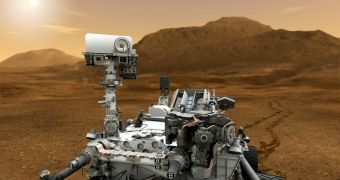Mission controllers with the NASA Jet Propulsion Laboratory (JPL), in Pasadena, California, announce that the Mars Science Laboratory (MSL) rover Curiosity has finally put a couple of weeks of electrical and software issues behind it. The robot resumed scientific operations on Saturday, November 23.
About a week ago, on November 17, the rover experienced an unexpected change of voltage inside its main bus, the instrument that delivered power throughout the vehicle. This shift prompted computers aboard the 1-ton machine to go into safe mode, to prevent any damage from coming to the systems.
Since engineers opted for a floating bus design for the rover's electrical system, Curiosity can endure significant voltage changes without experiencing short circuits. This design is what protected it during the November 17 event, JPL scientists say.
Mission controllers have spent the past few days trying to figure out the root cause of the voltage change. It is known that such events can make electrical systems more vulnerable to future glitches, so investigators were curious to see what the problem was.
“We made a list of potential causes, and then determined which we could cross off the list, one by one,” explains JPL rover electrical engineer, Rob Zimmerman. He was part of a team that spent six days analyzing the source of the error, before finally allowing Curiosity to resume conducting science.
Researchers found that the Multi-Mission Radioisotope Thermoelectric Generator, the nuclear engine that powers Curiosity, is the most likely source of the short circuit that triggered the voltage change.
Over time, shorts are unavoidable in such engines, physicists say. Other NASA missions featuring the same propulsion method have experienced the same type of shorts. However, the robust design used to construct Curiosity will safeguard it against any damage.
Over this weekend, November 23-24, the rover returned to normal science operations. Its robotic arm was used to collect a sample of powered rock, and then transfer it into the laboratory Curiosity carries inside it. The sample has been stored inside the robotic arm for more than six months.
Due to its instruments, the rover is able to conduct different types of studies on the same sample. Portions of the material in the robotic arm are gradually inserted into the rover's internal ovens, and then analyzed until valid date are produced. Another piece of the sample is then added, and so on.

 14 DAY TRIAL //
14 DAY TRIAL //